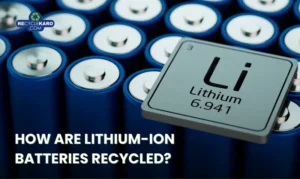What are Rare Earth Elements? [Meaning, Properties, Application]

Rare earth elements are crucial to modern technology. They power our smartphones, computers, and electric vehicles. These elements are the backbone of high-tech industries.
Despite their name, rare earths are not truly rare. They are found in many parts of the world. However, they are difficult to mine economically.
China dominates the rare earth market. It controls over 80% of the global supply. This dominance raises concerns about supply security.
Rare earth elements have unique properties. They are essential for renewable energy technologies. Wind turbines and electric vehicles rely heavily on them.
The demand for rare earths is growing. As technology advances, so does the need for these elements. The transition to green energy further boosts this demand.
India has significant rare earth reserves. Yet, it faces challenges in extraction and processing. Overcoming these hurdles could boost its economy.
The future of rare earth elements is promising. Innovations in extraction and recycling are underway. These advancements aim to meet rising demand sustainably.
Environmental concerns are linked to rare earth mining. Responsible practices are necessary to mitigate these impacts. Balancing demand with sustainability is crucial.
The geopolitical landscape of rare earths is shifting. Countries are seeking to diversify their supply chains. This shift could reshape global trade dynamics.
Rare earth elements are vital for defense industries. They are used in precision-guided munitions and other systems. Their strategic importance is recognized worldwide.
Understanding rare earth elements is essential. Their role in technology and industry is significant. This article explores their future prospects and challenges.
What Are Rare Earth Elements? Definition and Overview
Rare earth elements, often abbreviated as REEs, comprise 17 chemically similar elements. They include the 15 lanthanides on the periodic table, alongside scandium and yttrium. Despite their name, these elements are not truly scarce; they are relatively plentiful in the Earth’s crust but are dispersed and rarely found in concentrated forms.
The term “rare earth” was coined in the late 18th century. Researchers discovered these elements in uncommon minerals. Their unique properties were soon realized, leading to extensive research and development.
Rare earths are distinguished by their remarkable magnetic, luminescent, and electrochemical characteristics. These properties make them indispensable in various technological applications. From everyday gadgets to sophisticated defense systems, rare earths play a pivotal role.
The periodic table reveals much about these elements. They reside in the f-block, known for their complex electron configurations. This distinct placement highlights their unusual chemical behavior.
Here’s a breakdown of rare earth elements:
- Lanthanides: Lanthanum, cerium, praseodymium, neodymium, promethium, samarium, europium, gadolinium, terbium, dysprosium, holmium, erbium, thulium, ytterbium, and lutetium.
- Others: Scandium and yttrium are included due to similar chemical properties.
The importance of rare earths extends to various high-tech fields. They are essential for making strong magnets, catalysts, phosphors, and alloys. These elements improve the efficiency and performance of modern devices.
Many industries are heavily reliant on rare earths. Electronics, energy, automotive, and aerospace sectors depend on them. Such widespread use underscores their critical role in economic and technological development.
Understanding what are rare earth elements is key to appreciating their impact. Despite mining and processing challenges, their influence is undeniably vast. As technology advances, the strategic importance of REEs continues to grow, emphasizing the need for sustainable and innovative solutions.
Rare Earth Elements Properties: Chemical and Physical Characteristics
Rare earth elements are renowned for their unique chemical and physical properties. These characteristics make them indispensable in various high-tech applications. Understanding their nature begins with exploring their electron configurations.
REEs have partially filled f-orbitals. This configuration plays a critical role in their chemical behavior. It contributes to their magnetic, optical, and electronic properties, setting them apart from other elements.
Physically, rare earths are typically silvery-white metals. They exhibit high luster. However, they can tarnish when exposed to air. Their density and specific heat capacity make them suitable for high-temperature applications.
The atomic and ionic radii of these elements decrease progressively with increasing atomic number. This “lanthanide contraction” affects their binding energies and reactivity. It also impacts how they alloy with other metals.
In terms of magnetic properties, REEs are exceptional. Some, like neodymium and dysprosium, are key in making powerful permanent magnets. This magnetic prowess is essential for electronic devices and wind turbines.
Optically, these elements fluoresce when excited by ultraviolet light. Europium and terbium phosphors, for instance, are crucial in display technologies. Their luminescence enables vibrant colors and energy-efficient lighting solutions.
Overall, the chemical versatility of REEs stems from their ability to form various complex compounds. Whether in the role of catalysts or enhancing the properties of alloys, these elements provide endless possibilities. By harnessing their properties, industries can innovate and produce cutting-edge technologies.
How Many Rare Earth Elements Are There? Understanding the Group
Rare earth elements consist of a specific group on the periodic table. There are 17 elements in total, encompassing lanthanides, scandium, and yttrium. These elements are known for their shared chemical traits.
The lanthanides form the majority of this group. They include:
- Lanthanum
- Cerium
- Praseodymium
- Neodymium
- Promethium
- Samarium
- Europium
- Gadolinium
- Terbium
- Dysprosium
- Holmium
- Erbium
- Thulium
- Ytterbium
- Lutetium
In addition to the lanthanides, scandium and yttrium are considered rare earth elements due to similar properties. These elements often occur together in nature. They are typically extracted from the same mineral deposits.
Despite being labeled “rare,” these elements are relatively abundant in the Earth’s crust. However, they rarely occur in concentrated forms. This scarcity in minable quantities makes them challenging to extract economically. Understanding the full scope of this element group is vital for industries that rely heavily on their specialized applications. From electronics to renewable energy, the specific number and identity of rare earth elements are key to technological advancements.
Rare Earth Minerals and Materials: Sources and Types
Rare earth minerals are not as rare as their name implies. They are widely dispersed in small amounts across the globe. However, their economic extraction often poses a challenge.
These minerals are usually found in specific types of rocks. The most common sources include bastnäsite, monazite, and xenotime. Each type contains different concentrations of rare earth elements.
Bastnäsite primarily comprises cerium and other light rare earth elements. These are often processed to extract valuable materials used in numerous high-tech applications.
Monazite is another key source, rich in both light and heavy rare earth elements. It is often found in beach sands. Monazite’s mining and processing come with environmental considerations due to thorium.
Xenotime, rich in yttrium and heavy rare earth elements, is rarer than the other two. It is often extracted from placer deposits.
Aside from these major minerals, rare earth elements also reside in non-conventional sources. These include phosphorites, geothermal fluids, and coal by-products.
Mining and processing these minerals require specialized techniques. This often involves complex chemical processes to isolate each element.
The diversity of mineral types underscores the extensive applications of rare earth materials. From electronics to defense, these minerals are crucial. Understanding their sources is essential for future innovations and supply chain sustainability.
Global Distribution of Rare Earth Minerals: Key Producers and Reserves
The global landscape of rare earth minerals is quite uneven. A few countries dominate production due to abundant reserves and efficient extraction methods. China is the leader, controlling over 80% of the market. Its vast resources and cost-effective processing make it a powerhouse in this sector.
Beyond China, other significant contributors include Australia and the United States. They have invested in mining technologies to compete in the global market. Australia’s reserves are concentrated in Western Australia, home to some of the world’s largest deposits.
Other nations with notable reserves include Brazil, India, and Russia. Each holds potential but faces distinct challenges in scaling up production. For instance, geopolitical factors and environmental regulations can impede progress.
Japan and South Korea rely heavily on imports despite advanced technologies. They have limited domestic resources, amplifying the need for strategic sourcing partnerships.
India, with substantial reserves, aims to boost its market presence. However, challenges in mining technology and regulatory frameworks often hinder growth. The country is focusing on developing new extraction techniques.
Rare earth minerals are found in diverse geological settings globally. The leading producers and reserves are a testament to the strategic significance of these minerals.
Key Global Producers and Reserves
- China: Leader with significant control over global production.
- Australia: Increasing its market share with sustainable practices.
- United States: Investing in domestic production to reduce dependence.
- Brazil, India, Russia: Emerging players with untapped potential.
- Japan, South Korea: Heavy reliance on imports due to limited local resources.
Understanding these dynamics is crucial for strategic planning. As technology evolves, the need for rare earth elements will only grow. Ensuring a diverse supply chain can help mitigate risks associated with geopolitical tensions or market volatility. The global distribution of rare earth minerals continues to shape the future of numerous industries.
Rare Earth Minerals in India: Potential and Challenges
India holds a promising position in the rare earth minerals market. With vast reserves, the country possesses significant potential for growth in this sector. However, unlocking this potential comes with challenges that require innovative solutions.
The Indian subcontinent is rich in monazite, a key source of rare earth elements. Found along the coastlines, these deposits offer substantial opportunities for extraction. Despite the abundance, India lags in production due to several constraints.
One of the primary obstacles is the lack of advanced mining technology. Traditional methods used are not as efficient or sustainable, affecting output and environmental impact. Investment in cutting-edge technologies could transform the sector.
Regulatory hurdles also impede progress in India’s rare earth industry. Complex rules around mining licenses and land acquisition delay projects. Streamlining these regulations could accelerate development and attract foreign investment.
Environmental concerns represent another significant challenge. The process of extracting rare earth minerals is associated with ecological damage. India must adopt sustainable practices to minimize these impacts and meet global standards.
India’s strategic importance in the rare earth market lies in its reserves and potential for innovation. By addressing these challenges, the country can enhance its role globally.
Challenges Facing India’s Rare Earth Industry
- Lack of Advanced Technologies: Traditional methods hinder progress and sustainability.
- Regulatory Complexity: Bureaucratic hurdles slow down project execution.
- Environmental Concerns: Ecological impacts need sustainable solutions.
- Investment Needs: Capital and expertise are crucial for growth.
Through investments, policy reforms, and sustainable practices, India could become a significant player in the rare earths market. These changes would not only benefit domestic industries but also contribute to global supply chain stability.
Extraction and Processing of Rare Earth Elements
The extraction and processing of rare earth elements (REEs) are intricate processes requiring specialized techniques. These processes are critical for separating and purifying the elements from their mineral sources.
Initially, rare earth minerals such as bastnäsite and monazite are mined from the earth. Once extracted, the minerals are processed through several steps to isolate the valuable REEs. This begins with crushing and grinding the ores to increase surface area for further processing.
The next step involves physical separation methods, often using magnetic and flotation techniques. This stage aims to concentrate the rare earth minerals from other non-desirable materials. Once concentrated, the material undergoes chemical processing.
Chemical extraction involves dissolving the concentrated ores in acids. This leaching process separates the REEs into a solution. To isolate specific elements, various solvents and chemical agents are utilized in a process known as solvent extraction.
Separation efficiency is crucial, as individual rare earth elements possess unique properties and uses. Each element is precipitated and purified through repeated solvent extraction cycles. The final product is usually in the form of oxides or metal alloys.
However, these extraction processes are resource-intensive and pose environmental challenges. The use of hazardous chemicals necessitates stringent environmental controls to prevent contamination. Moreover, processing REEs generates radioactive waste that requires careful management.
As the demand for rare earth elements continues to rise, innovations in extraction technologies are vital. Sustainable and efficient methods are being developed to minimize environmental impacts and improve yield.
Key Steps in REE Extraction and Processing
- Mining: Extracting the ore from deposits like bastnäsite and monazite.
- Physical Separation: Using magnetic and flotation techniques to concentrate minerals.
- Chemical Processing: Leaching, solvent extraction, and purification.
- Environmental Management: Addressing radioactive and chemical waste.
Advancements in these processes promise to reduce costs and environmental impact. As technology evolves, the rare earth industry seeks balance between economic benefits and ecological responsibility.
Rare Earth Elements Uses: Applications Across Industries
Rare earth elements (REEs) are integral to many modern industries, thanks to their unique properties. These elements enhance the efficiency and functionality of various technologies.
High-Tech Electronics
Rare earths are pivotal in producing consumer electronics. Devices like smartphones, computers, and televisions rely on these elements to improve performance. REEs are essential in making bright, energy-efficient displays and robust rechargeable batteries.
Renewable Energy Technologies
The transition to a greener economy relies heavily on rare earths. Wind turbines and solar panels use REEs to optimize energy capture and conversion. Moreover, electric vehicle motors depend on high-strength permanent magnets made from neodymium and dysprosium.
Aerospace and Defense
In aerospace and defense sectors, REEs provide lightweight, strong materials vital for advanced systems. They are used in precision-guided munitions and stealth technologies. Rare earths improve the durability and efficiency of aircraft and missiles.
Healthcare and Medicine
Medical imaging and diagnostic equipment benefit greatly from rare earths. Elements like gadolinium enhance magnetic resonance imaging (MRI) capabilities, providing clearer and more accurate images. This facilitates better diagnosis and treatment planning.
Industrial Catalysts
In the chemical industry, catalysts containing rare earths speed up reactions and reduce energy use. These catalysts are particularly crucial in refining petroleum and producing clean fuels. They also play a role in various chemical synthesis processes.
Telecommunications and Networking
Rare earths are vital for telecommunications infrastructure, supporting faster data transmission. Fiber optics and other networking equipment employ REE-based materials to enhance signal clarity and reach. This ensures efficient and reliable communication networks.
Automotive Innovations
Beyond electric vehicles, rare earths improve traditional automotive technologies. Catalytic converters and emission control systems use REEs to reduce pollutants, making combustion engines cleaner and more efficient.
Environmental Technologies
Rare earths assist in creating sustainable environmental solutions. They are used in advanced water filtration systems and pollution control technologies. REEs contribute to reducing industrial emissions and enhancing resource recovery.
Rare Earth Elements in High-Tech and Green Technologies
Rare earth elements are at the core of high-tech innovations and green technologies. Their unique properties enable breakthroughs that power both industries.
Revolutionary Electronics
The electronics sector harnesses the strength and efficiency provided by rare earths. High-performance magnets in smartphones and computers ensure enhanced sound quality and faster processors. This makes our gadgets more powerful yet compact.
Transition to Clean Energy
Clean energy systems rely heavily on REEs for efficiency and sustainability. Wind turbines use rare earth magnets to generate electricity at lower wind speeds. This increases energy output, vital for expanding renewable infrastructure.
Solar Power Enhancements
In solar technology, REEs contribute to the efficiency and durability of panels. They help in capturing solar energy more effectively, optimizing the performance of photovoltaic cells. This advancement reduces costs and increases solar adoption.
Automotive Advancements
Rare earths also revolutionize the auto industry by improving fuel efficiency and reducing emissions. They are key in electric and hybrid vehicle technologies, playing a significant role in motors and batteries.
Role in Grid Storage
In energy storage, REEs support the development of advanced batteries. These batteries are pivotal for stabilizing renewable energy sources and ensuring reliable electricity supply. They contribute significantly to achieving energy security.
List of Key Rare Earth Contributions:
- Enhanced electronics performance
- Increased renewable energy efficiency
- Advanced transportation solutions
- Improved grid storage systems
Environmental Stewardship
Green technologies leveraging rare earths aid in addressing environmental challenges. They help in reducing carbon footprints and enhancing energy efficiency. As societies prioritize sustainability, the demand for REEs will only grow.
By fostering innovations in high-tech and green fields, rare earth elements pave the way for a sustainable future. Their applications are central to reducing dependency on fossil fuels and enabling cutting-edge electronic technologies. The role of REEs in future technological solutions is not merely beneficial; it is essential.
Economic Impact of Rare Earth Elements: Markets and Trade
Rare earth elements hold a pivotal role in the global economy. Their influence spans multiple markets, impacting trade dynamics significantly.
Strategic Importance
As essential components in technology, REEs are valuable commodities. Industries worldwide rely on them for innovative developments, driving economic growth.
Market Dynamics
The REE market is characterized by its volatility and dependency on major suppliers. Any disruption can cause significant price fluctuations, affecting global markets.
Major Players and Producers
China remains the dominant force, accounting for over 80% of worldwide rare earth production. This near-monopoly grants it considerable influence over pricing and supply.
Diversifying Supply Chains
Efforts are underway to diversify supply chains for security and resilience. Nations are investing in new mining ventures to reduce dependency on a single supplier.
Economic List of Key Considerations:
- Price volatility linked to supply changes
- Influences on technology costs
- Impact of policy changes in producing countries
Trade Patterns
Trade in rare earths shapes international relationships. Policies, environmental considerations, and geopolitical tensions all play significant roles in their exchange.
This economic interplay highlights the critical balance nations must maintain between securing REE access and fostering technological advancement. The ability to navigate these complexities will determine the economic stability and competitiveness of countries in the global market. Understanding this landscape is crucial for policymakers and industry leaders strategizing for future developments.
Geopolitics of Rare Earths: Supply Chains and Strategic Importance
Rare earth elements play a crucial role in global geopolitics, affecting international relations and national security.
Strategic Leverage
Countries with REE resources hold strategic leverage. Their control can influence political and economic landscapes, leading to power shifts internationally.
Supply Chain Vulnerabilities
The current concentration of supply highlights vulnerabilities. Disruptions in major producing countries could lead to global supply crises, affecting various industries.
International Relations
Access to rare earths shapes diplomatic interactions. Countries aim to secure stable supplies through partnerships, negotiations, and investments in potential reserves.
National Security Considerations
REEs are vital for national security technologies. Military advancements often depend on these materials, making their supply a security priority for many nations.
Geopolitical Strategies:
- Reducing dependence on single suppliers
- Investing in technological innovations to find alternatives
- Strengthening alliances and trade agreements to secure resources
Balancing Act
Nations face a balancing act between securing supply and addressing environmental concerns. Strategies involve navigating complex geopolitical landscapes to maintain stability and ensure access.
The geopolitical significance of rare earths cannot be understated. As countries continue to navigate these challenges, their strategies around REE supply chains will influence future geopolitical stability and development. Understanding these dynamics is essential for policymakers and industry leaders planning for future security and technological advancement.
Environmental and Social Challenges in Rare Earth Mining
Mining rare earth elements presents significant environmental challenges. The process often involves disruptive land and water impacts, which demand careful management.
Environmental Degradation
Rare earth mining can lead to severe environmental degradation. Contaminated water, soil erosion, and biodiversity loss are common issues resulting from mining activities.
Pollution Concerns
The extraction process releases harmful chemicals. These pollutants can seep into waterways, affecting both ecosystems and human health over time.
Waste Management
Managing mine waste is a complex task. Tailings, containing toxic substances, require proper disposal techniques to prevent environmental damage.
Social Issues
Communities near mining sites face social challenges. Displacement, health risks, and limited access to resources are prevalent in these areas, impacting livelihoods.
Key Challenges in Rare Earth Mining:
- Habitat destruction and land degradation
- Water pollution from chemicals and heavy metals
- Health risks due to exposure to pollutants
- Economic and social disruption in local communities
Seeking Solutions
Efforts to address these issues include adopting sustainable mining practices. Innovations and stricter regulations aim to reduce negative impacts and promote responsible resource management.
Addressing these challenges is crucial for the sustainable development of rare earth resources. Balancing economic gains with environmental stewardship and social responsibility is essential for the future of this industry. Responsible mining not only safeguards natural ecosystems but also supports the well-being of communities and fosters long-term benefits.
Innovations in Rare Earth Extraction and Recycling
Technological advancements are reshaping the rare earth extraction landscape. Researchers are developing new methods to reduce environmental impact and improve efficiency.
Green Extraction Techniques
Innovative techniques aim to minimize chemical usage. Bio-mining uses bacteria to extract rare earth elements from ores, an eco-friendly alternative.
Solvent-Free Methods
Scientists are exploring solvent-free extraction methods. These reduce reliance on harsh chemicals and help prevent environmental contamination.
Recycling Initiatives
The recycling of rare earth elements is gaining attention. By reclaiming these materials from end-of-life products, we can lessen the demand for virgin ores.
Key Innovations in the Industry:
- Bio-mining for eco-friendly extraction
- Solvent-free processes for safer practices
- Enhanced recycling techniques to recover valuable elements
- Development of closed-loop systems for material reuse
Closed-Loop Systems
Closed-loop recycling systems integrate material recovery. These systems ensure rare earths are reused in new products, minimizing waste.
Future Prospects
The future of rare earth innovation looks promising. As technology evolves, these new techniques could transform the industry, making it more sustainable and efficient.
Encouraging advancements in extraction and recycling is vital. These innovations help balance resource needs with environmental care, paving the way for a sustainable rare earth industry. By employing cutting-edge technologies and improving recycling, we can better manage resources, protect the environment, and ensure a steady supply for future technological demands.
The Future Demand for Rare Earth Elements: Trends and Forecasts
The future demand for rare earth elements is closely tied to technological growth. As innovation progresses, rare earths are becoming more integral to various industries.
Driving Forces Behind Demand
Several factors drive the increasing demand for rare earth elements. The rise of electric vehicles (EVs), advancements in renewable energy, and the proliferation of high-tech gadgets are key contributors.
The Impact of Electric Vehicles
Electric vehicles heavily rely on rare earths for motors and batteries. With more countries pushing for EV adoption, demand for these elements is projected to rise significantly.
Renewable Energy and Sustainability
Renewable energy technologies, such as wind turbines and solar panels, require rare earth elements. As the world shifts towards sustainable energy, rare earths play a crucial role in this transition.
High-Tech Industries
High-tech industries, including electronics and telecommunications, depend on rare earth elements. As consumer demand for advanced electronics grows, so does the need for these essential materials.
Emerging Trends to Watch
- Rising EV production fueling rare earth demand
- Increased investment in green energy technologies
- Expanding high-tech sectors leveraging rare earths
- Growing geopolitical efforts to secure supply chains
Forecasting the Future
Experts predict a steady rise in rare earth demand over the coming decades. This demand will likely spur exploration for new deposits and enhance recycling initiatives.
Navigating this growing demand involves strategic planning and investment. Industries must ensure sustainable practices while meeting consumer and technological needs, cementing rare earth elements’ role in future innovations. Managing this balance is crucial to maintaining economic and environmental health as we move forward.
Sustainable Solutions: Balancing Demand, Supply, and the Environment
Balancing the demand and supply of rare earth elements with environmental concerns requires a careful approach. Sustainability in rare earth mining and usage is becoming increasingly important.
Importance of Sustainable Practices
Sustainable practices are essential for minimizing the environmental impact of rare earth extraction. Mining operations can cause significant disruption to ecosystems if not managed responsibly.
Recycling and Reuse
Recycling rare earth elements from end-of-life products is a viable strategy. This approach helps reduce the need for new mining projects, cutting environmental costs.
Technological Innovations
Innovations in extraction technology can enhance sustainability. New methods aim to lower waste and use fewer harmful chemicals in the mining process.
Collaborative Efforts
Governments and industries must collaborate to develop sustainable mining guidelines. Such collaborations can ensure long-term availability while protecting natural resources.
Key Strategies for Sustainability
- Implement advanced recycling programs
- Invest in cleaner extraction technologies
- Develop strict environmental policies
- Encourage international cooperation on supply chain management
Future Prospects
The future of rare earths involves embracing sustainability. By managing resources efficiently and responsibly, we can support technological advances while preserving the planet. Achieving sustainability in rare earth production is not just an option but a necessity for future generations. Balancing these elements will ensure that future demands are met without compromising the environment.
Conclusion: The Road Ahead for Rare Earth Elements
Rare earth elements have become indispensable in modern technology and various industries. Their unique properties make them critical to numerous applications, from smartphones to renewable energy systems.
The future of rare earth elements hinges on sustainable practices. Ensuring an adequate supply while minimizing environmental impact requires innovative approaches and international cooperation.
Economic and geopolitical factors will continue to shape the rare earth market. Countries are increasingly focused on securing reliable supply chains to reduce dependency on dominant producers like China.
Recycling and technological advancements will play pivotal roles. Efforts to improve recycling processes and develop less harmful extraction methods are essential for sustainability.
Ultimately, achieving a balance between demand, supply, and environmental stewardship will define the path forward. The ongoing commitment to sustainable practices and innovations will ensure rare earth elements remain accessible for future technological advancements.





You can find all the useful information you need on the Vavada mirror. Find out why players switch to the official Vavada website via the mirror, and discover the benefits: similar registration and login processes, bonuses, promo codes